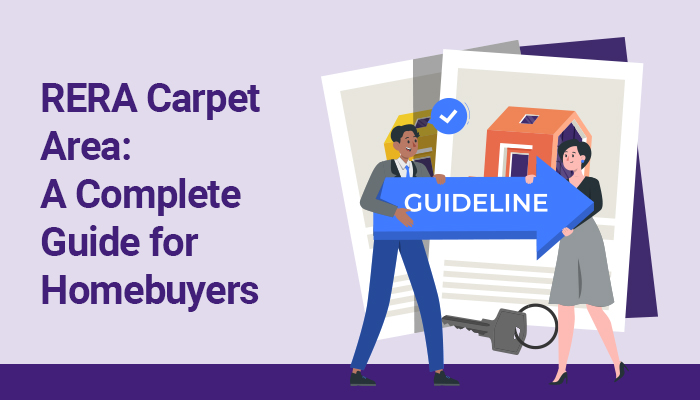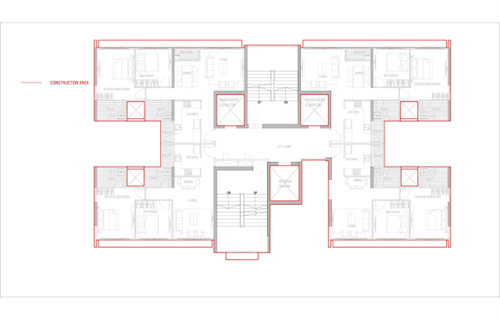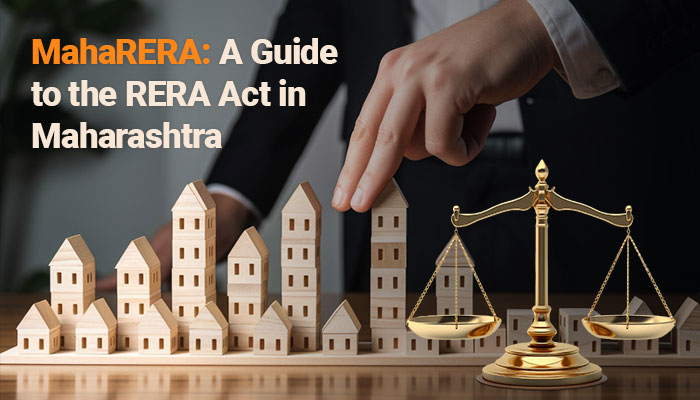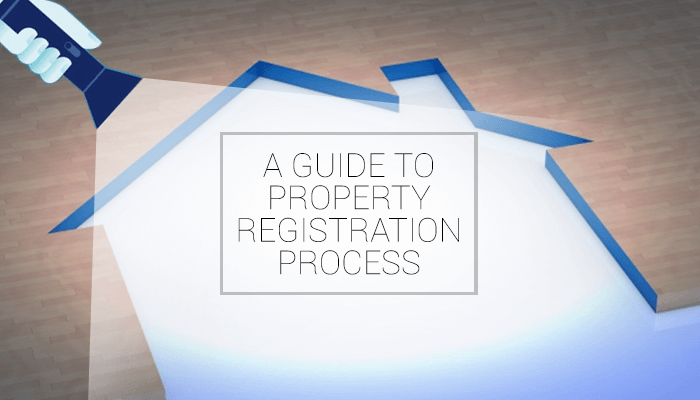What is RERA Carpet Area? A Complete Guide for Homebuyers

Understanding the carpet area is essential for homebuyers in India, especially after the introduction of the Real Estate (Regulation and Development) Act (RERA). RERA has standardized the definition of carpet area, ensuring transparency and protecting the interests of buyers. In this guide, we will look at understanding carpet area and its effect on housing loans.
What is RERA Carpet Area?
The RERA carpet area refers to the "net usable floor area" within the walls of a residential unit. This excludes areas such as balconies, terraces, and any shared spaces outside the four walls of the home, offering buyers a clear and concise measurement of the actual living space they are paying for.

For home buyers, understanding this term is essential. In the past, real estate developers often advertised built-up areas or super built-up areas, which included common areas like lifts, corridors, and clubhouses. This led to confusion, as buyers often paid for spaces they didn’t directly use. RERA’s definition eliminates this ambiguity, allowing homebuyers to make more informed decisions based on the actual livable space within their home.
Difference between RERA Carpet Area and other measurements
The difference between carpet area and RERA carpet area lies in transparency and legal backing. Carpet area as per RERA differs significantly from terms like built-up area and super built-up area.
- Super Built-up Area: Includes the carpet area, common areas, and external walls.
- Built-up Area: Includes the carpet area and internal walls.
- Usable Area: This term lacks standardization and can differ among builders and regions.
By familiarising themselves with what RERA carpet area is, home buyers can better understand what they are paying for and how it affects the overall pricing and home loan interest rate.
Key components of RERA Carpet Area
RERA carpet area comprises all the spaces enclosed by the internal walls of a home. It covers living rooms, bedrooms, kitchens, bathrooms, and even internal passageways. However, areas like external walls, balconies, open terraces, and communal spaces like lobbies or staircases do not count towards the carpet area.
This definition is important as it clearly defines portions of a property included in the calculation. Developers can no longer include areas that don’t contribute to the home’s livability, and buyers are shielded from paying for shared or unusable spaces. As a result, homebuyers have a more accurate idea of the actual size of their living space.
The carpet area is directly related to the property's price per square foot. A larger carpet area means a higher price. It's essential to compare the carpet area of different properties to make an informed decision.
How builders calculate RERA Carpet Area
To calculate the RERA carpet area, developers follow a simple formula. It involves measuring the usable space inside the walls of each room and adding them together. While walls are part of the built-up area, the carpet area only includes the open space available for actual use. You can calculate this using the RERA carpet area calculator.

Using a RERA carpet area calculator, buyers can verify the space being offered, which ensures no discrepancies when applying for a home loan as it affects home loan eligibility and the interest rates offered by lenders.
Legal and Financial implications of RERA Carpet Area
It is important to understand the legalities of the RERA carpet area for both the buyer and seller. Let's take a look.
- RERA Regulations for Carpet Area
RERA mandates builders to disclose the carpet area of properties accurately. Failure to do so can result in penalties or legal consequences. This ensures transparency and prevents buyers from being misled.
- Effect of RERA Carpet Area on Property Valuation
The carpet area is a significant factor in determining the property's valuation. A larger carpet area generally results in a higher valuation.
- Financial Impact of Carpet Area Miscalculations
Incorrect carpet area measurements can lead to financial losses for buyers. If the actual carpet area is smaller than advertised, it can impact the property's value and resale potential.
Steps for homebuyers to verify RERA Carpet Area
Verifying the carpet area in official property documents is necessary for every home buyer.
- Verifying the Agreement: The sale agreement should clearly state the carpet area as per RERA, and buyers should verify this with the approved floor plans and building layouts. Ensuring consistency across all documents is key to protecting your investment.

- Cross-Check Property Details: The RERA portal is an invaluable tool for verifying project details. Buyers can access the portal to find carpet area information about any registered project and can cross-check it against the builder’s claims. If discrepancies are found, buyers can file a complaint with the RERA authority to address the issue.
One common mistake is confusing carpet areas with built-up or super built-up areas, leading to incorrect price comparisons. Another issue is failing to compare the carpet area across different projects. It’s important to be thorough and ensure that the carpet area is consistent with RERA guidelines.
Wrapping Up
Understanding RERA carpet area meaning is essential for every homebuyer as it offers clarity, transparency, and legal protection. As you explore housing loan options, ensure that the carpet area is front and centre in your property considerations. This simple process can save you from costly mistakes. If you are looking for expert assistance to help you with your carpet area, or if you simply need guidance on property buying, visit IIFL Home Loans.
FAQs
Q1. What does RERA carpet area include?
RERA carpet area includes the usable floor space within the walls of a residential unit, excluding balconies, common areas, and external walls.
Q2. Is the carpet area the same as the usable area?
Not necessarily. The usable area might include some additional spaces that are not included in the carpet area, such as balconies or storage areas.
Q3. How can I calculate the carpet area of a property myself?
To calculate the carpet area, measure the internal dimensions of each room and sum them up. While you can do this manually, using professional measurement tools or services ensures accuracy and compliance with RERA standards.
Q4. Can I negotiate the price of a property based on the carpet area?
Yes, if there’s a discrepancy between the advertised carpet area and the actual measurement, you can leverage this information to negotiate a lower price with the seller, potentially saving on your investment.
Q5. What are the legal remedies if a builder misrepresents the carpet area?
If a builder misrepresents the carpet area, you can file a formal complaint with RERA, which may lead to an investigation. Legal remedies could include financial compensation or corrective measures by the builder.
Tags
Disclaimer: The information contained in this post is for general information purposes only. IIFL Home Finance Limited (including its associates and affiliates) ("the Company") assumes no liability or responsibility for any errors or omissions in the contents of this post and under no circumstances shall the Company be liable for any damage, loss, injury or disappointment, etc. suffered by any reader. All information in this post is provided "as is", with no guarantee of completeness, accuracy, timeliness, or of the results, etc. obtained from the use of this information, and without warranty of any kind, express or implied, including, but not limited to warranties of performance, merchantability, and fitness for a particular purpose. Given the changing nature of laws, rules, and regulations, there may be delays, omissions, or inaccuracies in the information contained in this post. The information on this post is provided with the understanding that the Company is not herein engaged in rendering legal, accounting, tax, or other professional advice and services. As such, it should not be used as a substitute for consultation with professional accounting, tax, legal or other competent advisers. This post may contain views and opinions which are those of the authors and do not necessarily reflect the official policy or position of any other agency or organization. This post may also contain links to external websites that are not provided or maintained by or in any way affiliated with the Company and the Company does not guarantee the accuracy, relevance, timeliness, or completeness of any information on these external websites. Any/ all (Home/ Loan Against Property/ Secured Business Loan/ Balance Transfer/ Home Improvement Loan/ NRI Home Loan/ Home Loan for Uniformed Services) loan product specifications and information that may be stated in this post are subject to change from time to time, readers are advised to reach out to the Company for current specifications of the said (Home/ Loan Against Property/ Secured Business Loan/ Balance Transfer/ Home Improvement Loan/ NRI Home Loan/ Home Loan for Uniformed Services) loan.
 Login
Login





















